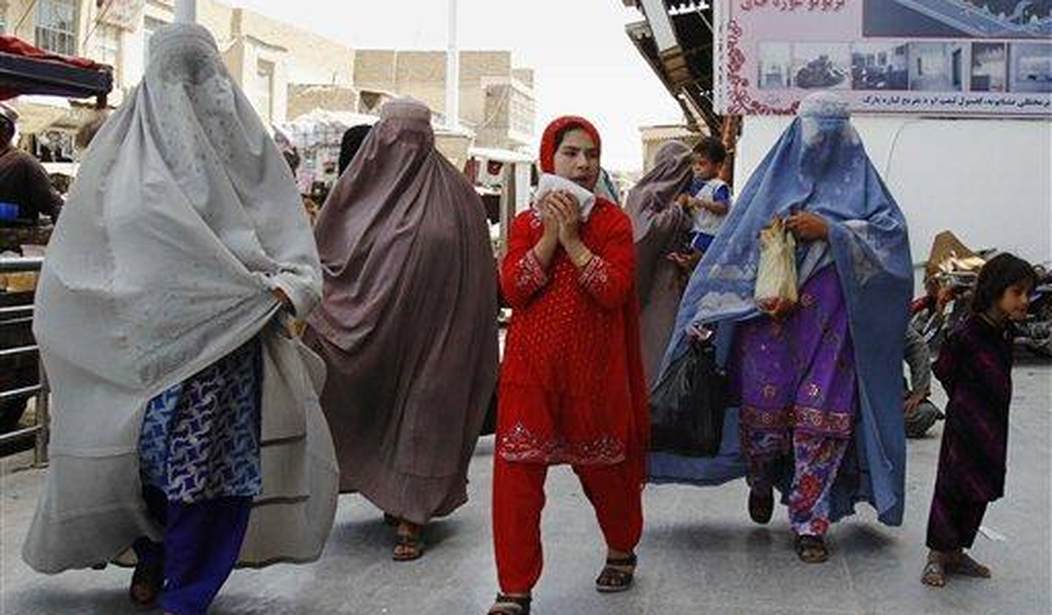On Friday, the courageous Iranian dissident Masih Alinejad, whom the Islamic Republic recently tried to kidnap in New York and take back to imprisonment, torture, and death in Tehran, posted a video on Twitter of a young Afghan woman. As the tears fall down her face, the woman says: “We don’t count because we were born in Afghanistan. I cannot help crying. I have to wipe my tears to be able to film this video. No one cares about us. We’ll die slowly in history. Isn’t it funny?”
No, it’s as tragic as this woman feels it to be, and the reason why it is happening gets right to the heart of why the American mission in Afghanistan failed so completely, and left young women such as the one in this video without anyone to defend them from the Taliban.
The woman in the video is not wearing a hijab, which gives the immediate impression that she is not an observant, Sharia-adherent Muslim. Political and military realities that are rapidly changing now may have obscured the fact for her, but this woman is not being abandoned now. She was abandoned years ago, in one of the foremost mistakes of our two-decade-long series of mistakes in Afghanistan.
"We don't count because we're from Afghanistan. We'll die slowly in history"
Tears of a hopeless Afghan girl whose future is getting shattered as the Taliban advance in the country.
My heart breaks for women of Afghanistan. The world has failed them. History will write this. pic.twitter.com/i56trtmQtF
— Masih Alinejad 🏳️ (@AlinejadMasih) August 13, 2021
In our early years in Afghanistan, once the Taliban was toppled, we set about nation-building, initially with an eye toward establishing a Western-style constitutional republic in Afghanistan. But State Department foreign policy experts drastically underestimated the Afghan people’s attachment to Islamic law (Sharia), and disastrously discounted Sharia’s political aspects in the naïve belief, fueled by Islamic apologists in the U.S., that Islam was a religion of peace that was perfectly compatible with Western secular models of governance.
The opposition to Sharia quickly gave way to their desire to be culturally sensitive. The Melbourne Forum on Constitution Building noted in 2018 that “most of the external actors, including the United States, American church groups and the United Nations, initially attempted to marginalise the role of Islam and Sharia in favor of liberal rights and freedoms. However, understanding that Islam and Sharia are entrenched parts of Afghan constitutional culture, foreign advisers such as Yash Ghai and Barnett Rubin, who were directly involved in the drafting process convinced external assistance providers to stand aside and leave Afghans to make choices on these sensitive constitutional questions.”
Related: Taliban Savages Demanded We Leave Afghanistan and Biden Obeyed, Putting Americans at Risk
And so the Afghan Constitution that Afghanistan’s then-President Hamid Karzai formally ratified on January 26, 2004, begins “in the name of Allah, the Most Beneficient, the Most Merciful” and is written in the name of “We the people of Afghanistan, believing firmly in Almighty God, relying on His divine will and adhering to the Holy religion of Islam.” The Constitution notes its appreciation for the “jihad and just resistance of all the peoples of Afghanistan.” It declares that “Afghanistan shall be an Islamic Republic, independent, unitary and indivisible state,” and that “the sacred religion of Islam is the religion of the Islamic Republic of Afghanistan.” The significance of this is spelled out explicitly: “No law shall contravene the tenets and provisions of the holy religion of Islam in Afghanistan.”
Only someone who is not familiar with the tenets of Sharia will not be aware that this meant that the Afghan Constitution institutionalized discrimination against women (as well as non-Muslims), and sharply restricted the parameters of this “democracy” to the constraints of Islamic law. Since both the Taliban and the U.S.-backed Afghan government offered Sharia, there was very little difference between them; the government’s variety was just a bit less stringently enforced. The young woman in this video may have lived in an area that allowed her some limited freedom to ignore the fact, but Sharia was actually always hanging over her head, as enshrined in the U.S.-backed Afghan Constitution. The U.S. never offered refuge to non-Muslims or women who were being brutalized in accord with Sharia provisions, or anything else that would have given the Afghan people a real choice. So American troops just looked all the more like foreign invaders who were there for their own benefit, and who had nothing to offer to the Afghan people.
Of course, if they had offered an alternative to Sharia, the Americans would have alienated many Afghans who might otherwise have been willing to play ball with them. But Afghanistan was not the closed Sharia society it is now even as recently as the 1970s. The U.S. offered nothing to the Afghans who might recall those days fondly. Perhaps an effort to win them over would have been foredoomed, and could even conceivably have widened the conflict. Without any attempt to offer any genuine alternative to the society the Taliban envisioned, however, the American efforts were pointless and, after so many lives lost and trillions spent, futile. The tragedy of this young woman is the tragedy of untold numbers of others, and when it came to America’s vaunted might, she was right: No one cared about such people.










Join the conversation as a VIP Member